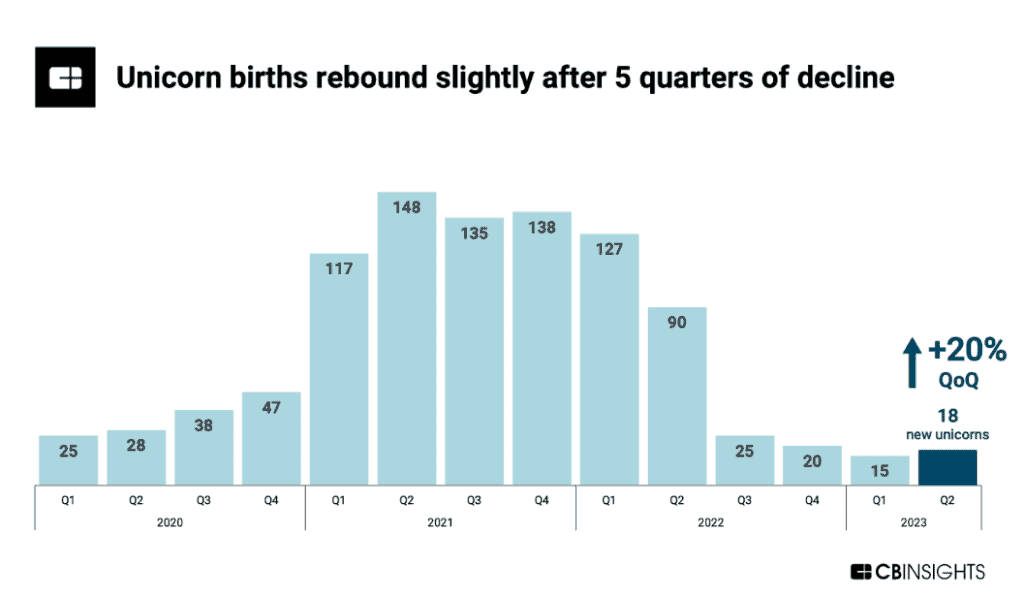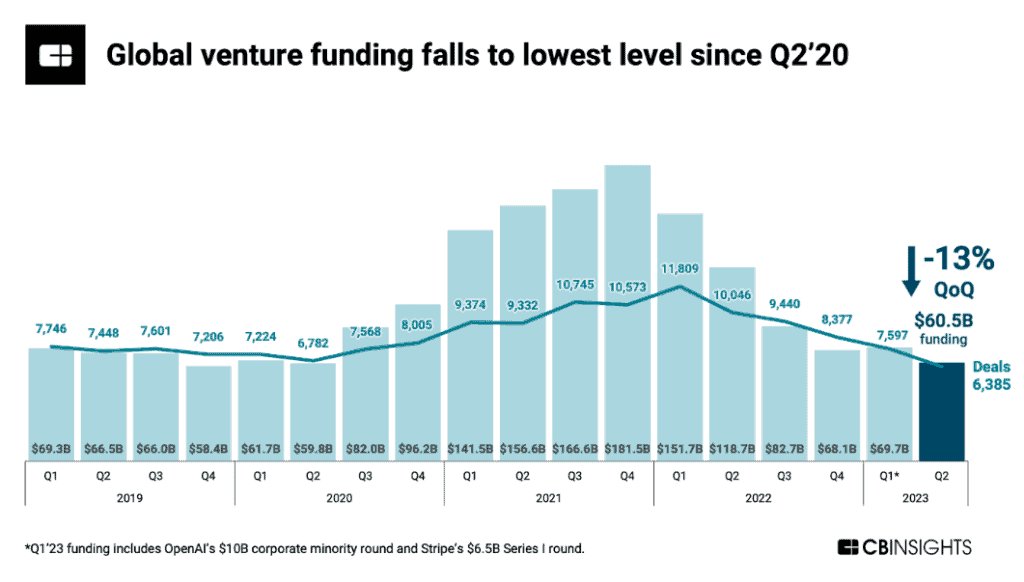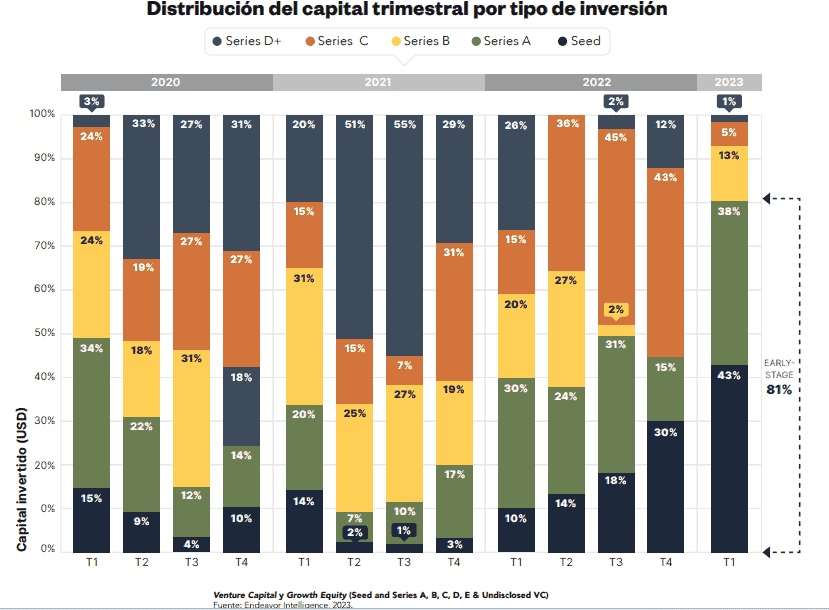It’s been over a year since the galloping of new Latin unicorns has been heard. From our research, it will be months before this happens again. According to the venture capitalists interviewed by Contxto, we will not see new Latin startups valued at more than USD $1,000 million in the short term. The most optimistic believe that we could have new unicorns in six months, but the majority agree that it will take 12 to 18 months for them to re-emerge. This is not a situation only in Latin America. The birth of unicorns worldwide has been declining for the last five quarters. On a global scale, 148 unicorns emerged in the second quarter of 2021, 90 unicorns during the second quarter of 2022, and this year, only 18 were born in the same period, based on data from CB Insights. Of these, half emerged in the United States and five in Asia. LATAM: Well, thanks. Last quarter, unicorns’ emergence reached its lowest level in the previous six years, with only 15 unicorns. In the second quarter, three more unicorns represented a 20% increase. 


The flow of capital will be reactivated for unicorns
Ricardo Sangion, the partner at TheVentureCity in his Brazil office, suggests that this year will be better than the last. “At least I already see startups talking a little more about their challenges and trying to start their funding rounds, and the VCs are also raising capital with the LPs.” The problem lies in the fact that for there to be new Latin unicorns, it is necessary to reactivate the rounds in advanced stages, and traditionally in Series B and Series C, there are no local funds in Brazil, Mexico, and all the countries of the region, says Sangion. Local funds are the ones that have remained active in investing in the region’s startups, so seed stages up to Series A have not been noticeably affected by the drought of capital for mature-stage startups. This is because “the more little money comes from many different sources, it can be from VC, but also from angels, crowdfunding, and acceleration programs. So the seed stage has more diversified sources,” says Sangion. Foreign capital is returning. A month ago, it was announced that QED Investors raised about USD$1,000 million for two new funds to support fintech startups worldwide, with particular attention to Latin America. With these new funds, the firm expects to add up to 45 new companies to its portfolio. Before that, Marcelo Claure, former executive of SoftBank, launched Bicycle, a fund focused on post-Series B stages in Latin America, with a first fund of USD$500 million. But things will be different. These investments will be more cautious, agree venture capitalists. “Before, companies with normal or good metrics could have access to capital and financing rounds or evaluations of more than USD$1,000 million; now, for those companies, that market no longer exists. However, it cannot be said that there are no companies that, even with the current situation, are raising rounds with millionaire valuations,” says Fernando Pontaza, founder and General Managing Partner of Invariantes in Guatemala. “If you go to the origin of unicorns, it has a lot to do with many investors who came to the market with a lot of money and eager to do things and paid very high valuations to invest in business models in the region, no doubt, understanding that there is huge potential, but forgetting a bit about the basics of how you evaluate a company in a growth process,” explains Fabrice Serfati, general partner and founder of Ignia.
When will there be new Latin unicorns?
Serfati does not doubt that Latin unicorns will reappear, only that they will return substantially more solid in the context of unit economics. “That’s going to be very positive for all of us who are in this field because the big problem we had is that the valuations represented the potential of a business, but it hadn’t been proven yet, in many cases, that each transaction generated profitability for the company and that was the big challenge we had,” specifies the Mexican investor. The investor whose fund has investments in three unicorns: Tiendanube, Rapyd, and Konfío (after buying Sr. Pago), estimates that “by the middle of next year we will see unicorns again, what will be relevant is to see how the level of investment in the ecosystem continues in these months; in the last quarter there was a significant decrease, now it is consolidating right now in the very early stages, and that makes you continue to build critical mass.” The situation looks better, according to Pontaza. “Perhaps after the close of this year and if inflation does not continue to accelerate, we may think that capital markets are reactivated a little in advanced stages. Now the custom is to raise bridge rounds with existing investors to continue maintaining some growth,” he notes. The investor from Invariantes predicts that “it will take at least six months to a year, if not more, for us to see more Latin unicorns.” Jimena Pardo, partner at ALLVP, does not doubt that there will be more Latin unicorns and increasingly frequent ones. “We will see them once macroeconomic cycles enter a more favorable market for risk investment and as more and more talent grows in the region.” U.S. funds, mainly, and Europe will return to Latin America because they have already seen some startups succeeding in familiar problems in their regions, such as e-commerce and last-mile delivery. “When they look at LATAM and see that the problems also exist here and that they are still not resolved and that there is a good team leading the process to bring the solution, they invest,” assures Sangion. However, the Brazilian investor states we will not see a direct impact this year. “We will not go back to things as fast and as big as we saw in 2020; it’s not an instant growth process.” Sangion explains that when startups receive capital, they must invest it, hire people, and attract customers, which takes time. Glisco Partners and Endeavor estimate that in Latin America, there are 47 “soonicorns” waiting to receive more capital rounds to reach unicorn status; that is, startups valued at USD$100 million or more and are awaiting mega games to place them on the unicorn tier. “These startups need to receive a substantial ticket, and valuations are now somewhat more modest. Right now, a round may put them very close to unicorn value, like USD$800 million. So, I think we will see some cycles probably of two rounds, and the rounds happen every 12 to 18 months,” details Sangion, who estimates that the harvest of Latin unicorns will occur in 2024 and 2025.
Is the unicorn title significant for success?
Latin America has only 3% of the total global unicorns, according to a study by Endeavor and Glisco Partners released in 2022. Of the entire unicorns in the region, 58% are in Brazil, 20% in Mexico, 13% in Argentina, 6% in Chile, and 3% in Colombia. In 2022, the emergence of unicorns continued; the startups that achieved mythical status were: Butterfly (Chile), Neon (Brazil), Dock (Brazil), Technisys (Argentina), Nowports (Mexico), Habi (Colombia), Kushki (Ecuador), Stori (Mexico), and Yaydoo (Mexico). And this 2023 has not seen a single new Latin unicorn. “Chasing that status and elevating valuations were allies, both company founders and investors willing to create unicorns at record rates, but now they are paying the price,” notes Pontaza from Invariantes. For him, the best sign of prosperity for the Latin entrepreneurial ecosystem is not unicorns but reactivating the investment sector in advanced rounds B, C, D, and beyond. Serfati, from Ignia, points out that “you don’t have to be a unicorn to be an exciting asset; the important thing is to sell that asset because if you don’t, all that you did was useless since you are not receiving money that you can be returning to your investors to reinvest.” “The most important thing is entrepreneurs creating solutions for the region, in our case, with technology, obsessed with their products to improve the lives of Latin Americans. Valuations are irrelevant until paid to you,” says Jimena Pardo from ALLVP in Mexico. The fact is that investors are becoming more selective and cautious in their investments and with valuations. “VCs may potentially have better performance by investing in this reality because of the quality of companies that we are accessing, with certain metrics; these are companies much better positioned and on firmer ground than when we were investing near the peak of this cycle around 2020 and early 2021,” explains Pontaza. For a VC, profitability only comes from exits, and their company ownership at entry specifies Pardo. “If you are entering at a slightly tighter valuation or the same, but with a more solid company and with greater visibility to have positive net profits, it indicates that you are at a better time to invest, and your funds will potentially have a better performance than at the most expensive peak of valuations,” adds Pontaza. What’s essential, says Serfati, is that more and more entrepreneurs want to solve problems through their business models.
“Unicorns are that little flag of ‘you’ve arrived,’ although not de facto, but it’s the publicity, and it’s what encourages more people to join this.”
“It’s always great to hear unicorn stories, but at the end of the day, if you invest in an initial valuation of USD$4 million and a company without raising much capital manages to sell for USD $200 million, and you did not dilute in many rounds, as an investor your result will be excellent,” explains Pontaza. “As it will be an excellent result for the company’s founders, who do not necessarily need to be a unicorn; we have had exits of companies that without being unicorns have represented seven or eight times our invested capital,” concludes Pontaza, who invests in startups throughout Latin America and the United States.







